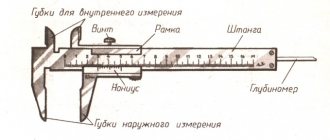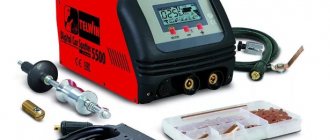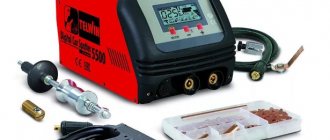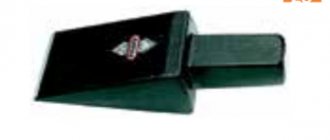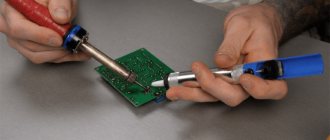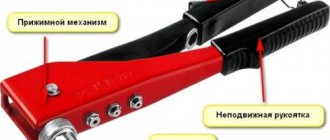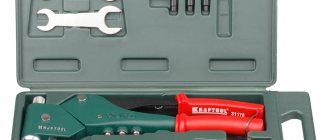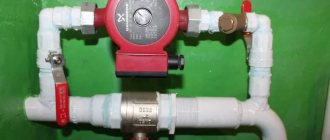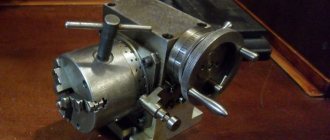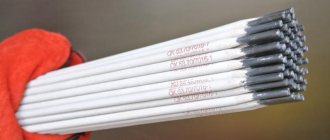The connection of thin sheets of metal, wood, various synthetic materials and even dense fabrics is often done with rivets, which require a special tool - a riveter.
Mechanical options have become widespread both in everyday life and in professional activities due to ease of use and relatively low cost.
At the same time, a battery-powered or pneumatic riveter is more productive.
The rivet joints themselves have a number of advantages over similar ones, including vibration resistance and increased strength.
As soon as the load exceeds the permissible value, the rivet stretches before breaking. But first things first.
Purpose and principle of operation of the rivet gun
The riveter is used to connect flat workpieces together, where the width of the contact points exceeds their thickness by 3 or more times.
For example, if you fold two identical strips of steel with dimensions 4x40 mm close together, their width will exceed the total thickness by 5 times.
In this case, the use of rivets as connecting elements is justified.
Riveting pliers, as riveters are otherwise called, are suitable for connecting parts with a total thickness of no more than 13 mm.
The tool is used in everyday life, in production, in construction and is indispensable in various repair shops.
A mechanical riveter is shaped like large pliers, and the principle of its operation is to transfer force from the handles - levers to the working mechanism, which installs the rivet element in the hole.
The fastening element itself consists of the following parts:
- A rivet is a tube with a cap located on one side.
- The core is a steel rod originally located inside the stave. It has an extension at its end.
As it works, the tool pulls the rod through the stave, expanding its tube.
At the moment when the force reaches a given value, the rod simply bites off.
The elementary principle of operation is what determines the high popularity of the riveter in the formation of strong joints.
Device operation process
Every person who decides to make repairs with their own hands asks the question: how to use the tool? The riveter is easy to use and does not require any specific knowledge. The operating principle of the tool is as follows:
- A through hole is drilled in the parts that need to be fastened together. In this case, it should be equal to the size of the rivet.
- It is necessary to insert the coupling rod into the hole so that the short part of the rivet is inside.
- The required nozzle is installed on the head of the rivet gun and pressed against the rivet. Physical force is used to squeeze the handles.
- Squeezing the handles a few times allows you to break off the rod, thereby interlocking the parts.
Device and characteristics
Since a manual riveter is the most popular and sought-after type of this tool, it will serve as an example for studying the main components.
The mechanical riveter is based on the following elements:
- The head is an element that fits directly onto the core of the rivet.
- The body acts as both a lower handle and a support frame.
- The upper handle is a power lever supported by an axis on the body.
- Working bushing and collet jaws. Their paired work secures the rivet shaft firmly after the handles are compressed. In addition, the cams serve to pull the rod out of the sleeve, resulting in the formation of a riveted ring. As the handles are unclenched, the bushing releases the collet mechanism, moving it to its original position.
- Spring – used to remove the core from the head. The stop for it is the cover, which is removed if you need to inspect the cams of the tool.
Main characteristics of riveters:
• Supported rivet type. These can be pull-out or threaded fasteners.
• Thickness of rivets and their material.
• Material of the body and coating of the handles.
• Lever length. The larger it is, the less force you need to apply when working.
• Weight and overall dimensions. The latter includes not only the width and height of the body itself, but also the length of the head, which determines the possible depth of its immersion in the holes, as well as the ability to work in limited space.
Material
For the manufacture of rivets, mainly chromium and tool steel are used, since the units are subject to regular loads.
Some models feature an aluminum body with chrome-molybdenum handles.
The handles are covered with PVC plastic.
Dimensions and weight
On average, mechanical riveters have the following dimensions:
- Length: 210 – 500 mm;
- Inner diameter of the cartridge: 2.4 – 8 mm;
- Chuck length: 24 – 70 mm;
- Weight: 300 – 1100 g.
The most widely used tool is with a handle length of 440 mm, a chuck length of 42 mm and an internal diameter of 2.6 mm.
Accordion-type riveters can weigh up to 4 kg.
Equipment
The delivery set of a good riveter includes interchangeable heads for different diameters of blind rivets.
For example, screw-on attachments for use on one tool are designed to work with fasteners with a diameter of 2.4, 3.2, 4, 4.8, 6, 6.4 mm.
The set of rivet guns for threaded rivets often also includes attachments for fasteners with a diameter of 5, 6, 8 and 10 mm.
Rating of the best riveters
| Nomination | Place | Name of product | Price |
| The best manual riveters | 1 | Kraftool rotary RX-33 31178 | 4 100 ₽ |
| 2 | HASKYY CHZ-15 lever | 3 000 ₽ | |
| 3 | STANLEY 6-MR77 | 2 230 ₽ | |
| 4 | Gross classic 40403 | 1 280 ₽ | |
| 5 | Bison 0-360° Bison | 820 ₽ | |
| 6 | Kraftool 31170-H6 | 1 090 ₽ | |
| 7 | BARS manual 40430 | 1 050 ₽ | |
| 8 | Matrix classic 40546 | 705 ₽ | |
| The best electric riveters | 1 | METABO NP 18 LTX BL 5.0 | 35 550 ₽ |
| 2 | EXTRATOOL RV-20103 | 42 935 ₽ | |
| 3 | MESSER ERA-M4-10 | 33 750 ₽ | |
| 4 | ABSOLUT Skytools SK64 | 36 000 ₽ | |
| 5 | Milwaukee M12 BPRT-0 4933464404 | 21 600 ₽ | |
| 6 | MESSER W4560 | 23 350 ₽ |
Types of riveters and their prices
The tool is divided primarily by drive type into:
Mechanical
Another name is a manual riveter, although, in fact, the following types of tools also belong to manual ones. Mechanical models are rightfully considered structurally the simplest. They are used both for work in workshops and at home.
Forming connections requires physical effort. The cost starts from 250 rubles, and the price of a quality instrument often exceeds 1,500 rubles.
Pneumatic
Operation is ensured by compressed air supplied from the compressor.
Pneumatic models are expensive, but at the same time the most powerful and productive.
The average cost is 12 - 20 thousand rubles for threaded options, and from 7 thousand for exhaust models.
Electric
Its performance is superior to mechanical options, and in addition, it requires virtually no effort during operation.
An electric riveter means a powered tool that is used in production and runs on a household network with a voltage of 220 V.
On average, the cost rarely falls below 10 thousand rubles.
Rechargeable
In fact, it is a subtype of electric riveter, with the only difference being that the power is supplied from a battery.
The price starts at 20 thousand rubles, and the cost of some models reaches 90 thousand rubles.
Pneumohydraulic
Or simply hydraulic - an industrial version, used for installing large threaded rivets.
Such models provide reliable fastening of parts with high clamping force, and are used primarily in the mechanical engineering industry.
The average cost is 3 – 7 thousand rubles.
Depending on the type of rivets used, there are:
• Blind (traction) – designed for installation of blind rivets. The main advantage is the low cost of consumables.
This type of rivet completely closes the hole in the workpiece. The tool is rightfully considered the most common due to its simplicity of design.
• Threaded – for mounting threaded rivets. It operates on a slightly different principle. Thus, a rivet has the form of a hollow tube, at one end of which there is an internal thread, and the opposite part is flared, in the manner of blind nuts.
A pin is screwed into the thread and pulled towards itself, as a result of which the thin metal between the thread and the flaring is crushed, firmly pressing the parts being connected to each other.
The connection is much stronger when compared with the previous version, but at the same time the cost of the rivets themselves is higher.
• Versatile. Suitable for working with blind and threaded rivets, supplied with appropriate replaceable heads.
According to the location of the working head relative to the body (handles), the tool can be:
- Direct type - the head is fixedly directed along the tool body, located in its end part. An alternative name is end riveter.
- Angular type - the head is fixed relative to the body at a right angle, or less often at another angle.
- Double-sided - a type of corner riveter, where the head can be moved to the back of the body by unscrewing it and screwing it into the seat with a key.
There are models where the head can be moved both to the top and side of the tool, which allows you to work in hard-to-reach places.
- Two-position - the head is installed in a position of 90°, or 180° relative to the body. In other words, it can be both straight and angular. Considering that the working part can be rearranged without the use of additional tools, this option has another name - an adjustable riveter.
- Rotating - the head relative to the body rotates at an angle of up to 360 degrees using a special hinge mechanism. A riveter with a rotating head is also preferable in cases where you plan to install rivets in hard-to-reach places.
Mechanical riveters are divided into several more types based on the design of the handles, and therefore the entire working mechanism as a whole.
The tool is:
One-handed
Outwardly it resembles a stapler for staples. It is for this reason that this option is called a rivet stapler.
A cheap rivet gun is made of silumin (an alloy of aluminum and silicon), which is not durable.
This option is suitable exclusively for installing aluminum rivets.
This material is also often used to make tools designed for plastic rivets.
A more expensive tool has a cast steel body, which has a positive effect on durability.
Single-handed rivet pliers are not intended for installation of fasteners made of hard materials, where great force is required by hand.
Therefore they are ideal for amateurs. As a rule, the diameter of the tightened fastener does not exceed 4.9 mm.
Two-handed
A tool designed to work with rivets made of any materials, including steel and stainless steel, as it develops a large working force.
Another name is a lever riveter, which in appearance vaguely resembles a bolt cutter.
Both of its handles are movable and made of durable material, which allows it to withstand significant loads for a long time.
This reinforced version of the tool is professional and allows you to work with rivets up to 6.5 mm thick, which affects its cost.
The power riveter is suitable for long continuous operation.
Rocker (accordion type)
A specially designed tool designed to perform work in hard-to-reach places.
Another name is a lever-folding riveter, which is due to its elongation when installed in a fastener cartridge, and folding when pressing on the handle.
Such models allow you to work with one hand, however, force can be applied by pressing with the whole body, and not just with the hand.
In addition to the standard rivet guns described above, a less common tool is also used for installing rivets:
Riveter
A pneumatic multifunctional tool, structurally reminiscent of a jackhammer.
The material is riveted using powerful impulses.
This impact tool can be easily converted into a chasing or chipping hammer by installing the appropriate attachment.
The price is rarely less than 5 thousand rubles.
Riveter adapter
Transforms an ordinary drill or screwdriver into an electric riveter.
Used primarily for small amounts of fastening work.
The attachment for a screwdriver costs about 2 – 5 thousand rubles.
Recommendations for choosing a riveter
Principle of operation
. Modern riveters differ in the way they flare the connecting element.
- Pull models are required for rivets consisting of a tubular body and a ball-tipped shank. The tool grabs the thin end of the rod, pulling it through the tube. The ball flares the rivet, and when it hits the base, the rod breaks off. The connection is not only strong, but also airtight.
- Screw devices operate on a different operating principle. There is a thread inside the rivet body. A screw is inserted into the head of the rivet gun, after which it is screwed into the hollow rivet. When the tool hits the base, the edge of the rivet begins to tighten and expand. After complete flaring, using the reverse function, the screw is unscrewed from the rivet. With this installation, the connection point is not sealed.
- Piston rivets are used when working with leather or fabrics. They are not designed for high loads. The riveter flares the tube using a cone-shaped nozzle. The connection is not sealed.
Type of drive.
There are several types of riveters, differing in drive.
- Mechanical or manual models are affordable, simple and compact. Installation of the rivet is carried out by squeezing only the hand or using two hands. Most often, a person’s physical strength is enough to work with blind rivets with a diameter of up to 5 mm. Such products are usually purchased for household use.
- When hundreds of rivets need to be installed during the day, even the strongest man will feel considerable hand fatigue. In this case, electric riveters come to the rescue. Just press the “start” button, and the electrical device will do all the work of installing the rivet. In this category there are network models that connect to a 220 V outlet, and rechargeable models that run on the energy of the built-in battery. The choice depends on the equipment of the workplace. For example, at a construction site or far from populated areas, a battery-powered riveter looks optimal. But in a garage or workshop you can comfortably use a network device.
- The most productive and reliable type of riveters are devices with pneumatic drive. They are used exclusively by professionals. These devices require compressed air to operate.
Tool equipment
. To work with rivets of different diameters, the riveter is equipped with additional nozzles. Manufacturers usually find a place on the body or handle where replacement heads or screws are securely secured. The more attachments in the set, the wider the scope of application of the tool.
Equipment.
When purchasing a tool, you should pay attention to the complete set of the riveter.
- A case or suitcase will allow you to store and transport not only the rivet tool, but also equipment, hardware, a key and other small items.
- For hood models, a useful device would be a container for collecting broken rods.
- A necessary element when changing attachments is a special key.
- In the case of battery-powered models, it will be useful to have 2 batteries.
Our review included 14 of the best riveters. All models are sold in the domestic retail chain. When allocating places, the editors of simplerule magazine relied on the opinion of experts, taking into account feedback from Russian users.
Advantages and disadvantages of different riveters
The fact that there are several types of riveters on the market is due to the presence of both pros and cons of their use.
Based on them, the tool is selected for work in specific conditions:
- • One-handed models develop a small working force, so they are used for installing rivets made of soft material, such as aluminum. At the same time, they are compact and require only one hand to operate.
- • Two-handed models, due to the presence of two reinforced levers, can easily cope with rivets made of hard material, such as steel. At the same time, the work is performed with two hands, which is somewhat inconvenient.
- • Rocker models support one-handed operation. The force can be increased by leaning on the mechanism with your whole body, which also provides support for the steel rivets.
At the same time, the accordion is not suitable for installing lightweight structures that cannot withstand the high pressure exerted on them required to tighten the fasteners.
Equipment Specifications
The mechanism of the riveter is practically no different from its type of use - professional or amateur. Its design includes the following components:
- a main body which includes a handle;
- at the end of the body there is a special head necessary for installing the rod (rivet);
- a lever made in the form of a handle with a lever mechanism;
- inside the structure there is the mechanism itself with a sleeve, which engages the rivet with the materials;
- spring.
In appearance, this tool may resemble pliers with a hint of a construction gun.
The adhesion of materials is achieved by squeezing two handles together.
How to choose a riveter?
When buying a household manual riveter “just in case,” which the owner plans to use extremely rarely, there is no point in choosing expensive models that, in principle, will never pay for themselves.
It is more advisable to pay attention to cheaper and simpler options.
The situation is different if you require a professional tool designed for long-term and continuous use.
There are not many nuances to choose from:
• One-handed models in the form of a pistol are the least reliable, since they are made of sheet steel and are not able to withstand high mechanical loads. Intensive work quickly destroys the main mechanisms.
• Lever models are much more reliable, and in addition, they belong to the professional class. Their massive handles, like the working mechanism itself, are capable of withstanding great forces for a long time.
The only thing better than this tool are similar models made from higher quality materials.
• All elements of the riveter must be made of sufficiently thick steel, which is quite difficult to break during operation. It is better not to even consider options with silumin components.
• The presence of a rotating head will provide ease of installation at almost any angle in hard-to-reach and inconvenient places.
The presence in the kit of replaceable heads for a wide range of diameters of fasteners will eliminate the need to purchase a second similar tool. In general, when choosing, you should focus on the weight of the riveter.
A good quality instrument cannot weigh little.
Therefore, before purchasing, it is better to hold several models in your hands. Even by assessing the difference in weight “by eye”, we can draw a conclusion about the quality.
Unknown manufacturers should also be avoided, which will definitely allow you to avoid wasted funds.
Conditions of use
Before purchasing a device, you need to determine the conditions of use:
- First, pay attention to the material being fastened (metals, wood, plastic).
- Also, depending on the type of materials, the material for making rivets is selected.
- Next, pay attention to the scope of work. It is better to purchase a professional device if it will be used daily.
- It is imperative to take into account the skill level of the person who will use the tool.
- Decide how much money you are willing to spend on purchasing a riveter.
Advantages of joining parts with rivets
Rivets can be found everywhere: from the cruiser Aurora to the Eiffel Tower. They are used in construction, during repairs, in mechanical engineering, and simply in everyday life. There are several reasons to choose rivets:
- reliability - rivets provide a connection of parts that is in no way inferior in strength to welding, does not give fatigue cracks and does not deform the workpiece;
- aesthetics - rivets with neat round heads look nice (certainly prettier than an amateurish weld);
- simplicity - unlike welding, to work with rivets you do not need to master a special working technique, and the skill comes very quickly;
- accessibility - an inexpensive riveter and the rivets themselves are enough to work: you don’t need a welding machine, a gas cylinder, a compressor, a generator, or special consumables;
- safety - when working with a riveter there are no sparks or heating, no explosive gas is used, so safety precautions for this device are much simpler than for a welding machine.
